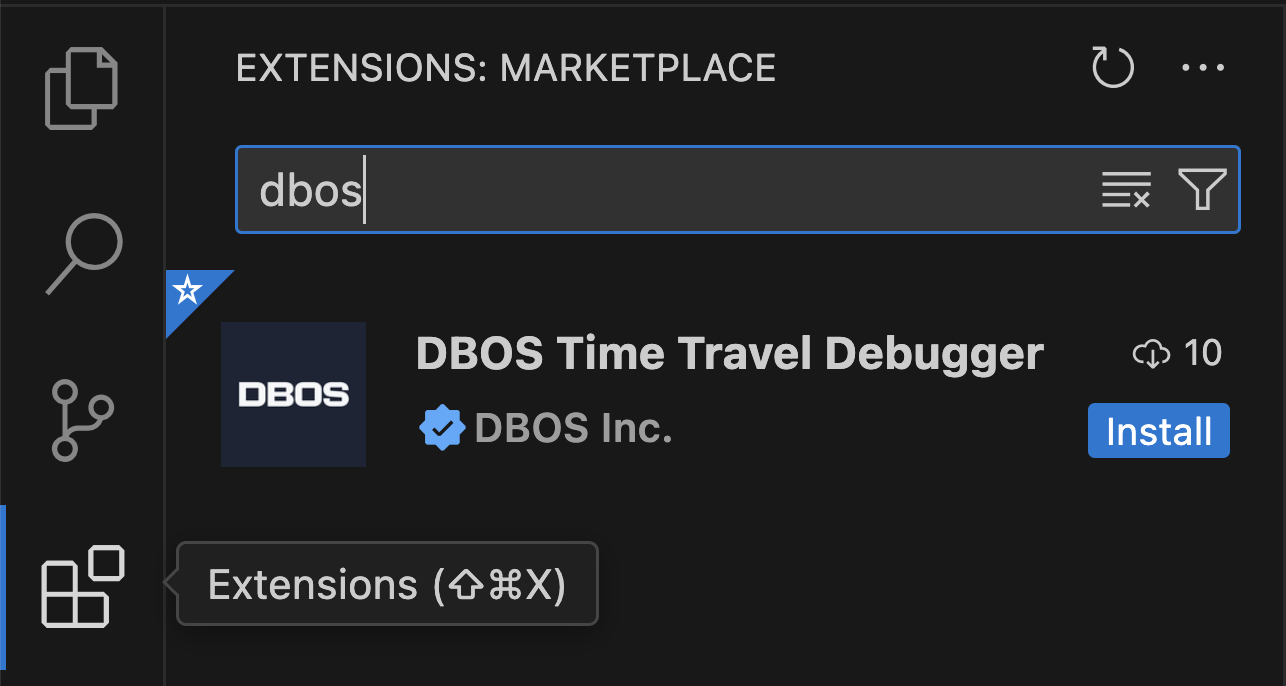Interactive Time Travel
Interactive time travel is only available for DBOS Cloud applications using the experimental time travel feature.
In this guide, you'll learn how to interactively time travel with DBOS Cloud: how to query your application's database as of any past point in time within the time travel data retention period of your current plan.
Preliminaries
Before following the steps in this guide, make sure you've deployed an application to DBOS Cloud with time travel enabled.
Time travel debugging uses Visual Studio Code and the DBOS Debugger Extension. The extension can be installed from the link above or by searching the Extension Marketplace inside VS Code for "DBOS"

Once installed, the DBOS Time Travel Extension will automatically update as new releases are published to the VS Code Marketplace.
- VSCode
- CLI
Open VSCode to your application folder. In the DBOS Cloud View, hover over the application you want to debug and select the Launch Debug Proxy menu item.
This automatically launches the time travel proxy and connects it to your application database instance.

Open a terminal window and navigate to the folder where you downloaded the pre-compiled debug proxy binary file (debug-proxy).
cd <Your Download Folder>/
chmod +x debug-proxy
./debug-proxy -db <app database name>_dbos_prov -host <app cloud database hostname> -password <database password> -user <database username>
The DBOS time travel proxy securely connects to the provenance database, an append-only replica of your application database maintained by DBOS Cloud. It uses the historical information in this database to run time-travelled queries without modifying your application database.
Running Time-Travelled Queries
In this tutorial, we interactively run time-travelled queries on your application database using psql.
First, connect psql to your local time travel proxy:
psql -h localhost -p 2345 -U postgres
By default, any queries you run will reflect the current state of your database.
Let's assume you've deployed a simple application to DBOS Cloud.
The application's dbos_hello table tracks how many times each person has been greeted.
The following query tells you how many times Mike has been greeted:
postgres=> select greet_count from dbos_hello where name = 'Mike';
greet_count
-------------
8
Now, let's time travel!
To view your database at a past point in time, you can set the timestamp through the special DBOS TS <timestamp>; command.
We support any timestamp string in RFC 3339 format.
For example, to view your database at 4:00:00 PM PDT (UTC-07:00) on 2024-04-26, and see how many times Mike had been greeted as of then, run:
postgres=> DBOS TS '2024-04-26T16:00:00-07:00';
postgres=> select greet_count from dbos_hello where name = 'Mike';
greet_count
-------------
4
You can run any SELECT statement on the database to query its state as of the timestamp you chose.
Statements that modify schemas or data (INSERT, UPDATE, DROP TABLE, etc.) will not have any effect.
At any time, you can run DBOS TS <timestamp>; again to travel to a different time.
You can also run DBOS SNAPSHOT RESET; to return to the present time.
Interactive Time Travel Command Reference
When interactively querying your DBOS Cloud database, the following additional commands can be invoked from the
psql command prompt.
As is typical for SQL commands, the interactive time travel commands are case insensitive.
DBOS TIMESTAMP
Can be shortened to DBOS TS
Sets the time travel debugger to a specific point in time for time travel queries. The timestamp can be specified in
RFC 3339 format (example: 2024-04-22T14:56:56-07:00)
or as an integer indicating the Unix epoch in milliseconds. RFC 3339 formatted timestamps
must be enclosed in quotes.
Examples:
DBOS TIMESTAMP "2024-04-22T14:56:56-07:00";DBOS TS "2024-04-22T14:56:56-07:00";DBOS TIMESTAMP 1234567890;
DBOS WORKFLOW
Can be shortened to DBOS WF
Sets the time travel debugger to the specific point in time when a specified workflow started. Workflows are identified by their workflow UUID, which can be found in the Monitoring Dashboard. The workflow UUID must be enclosed in quotes when using this command.
Examples:
DBOS WORKFLOW "7eb0968a-fbf0-4af2-909f-51d8516e7351";DBOS WF "7eb0968a-fbf0-4af2-909f-51d8516e7351";
DBOS SNAPSHOT RESET
Resets the time travel snapshot to the current time. Example:
DBOS SNAPSHOT RESET;